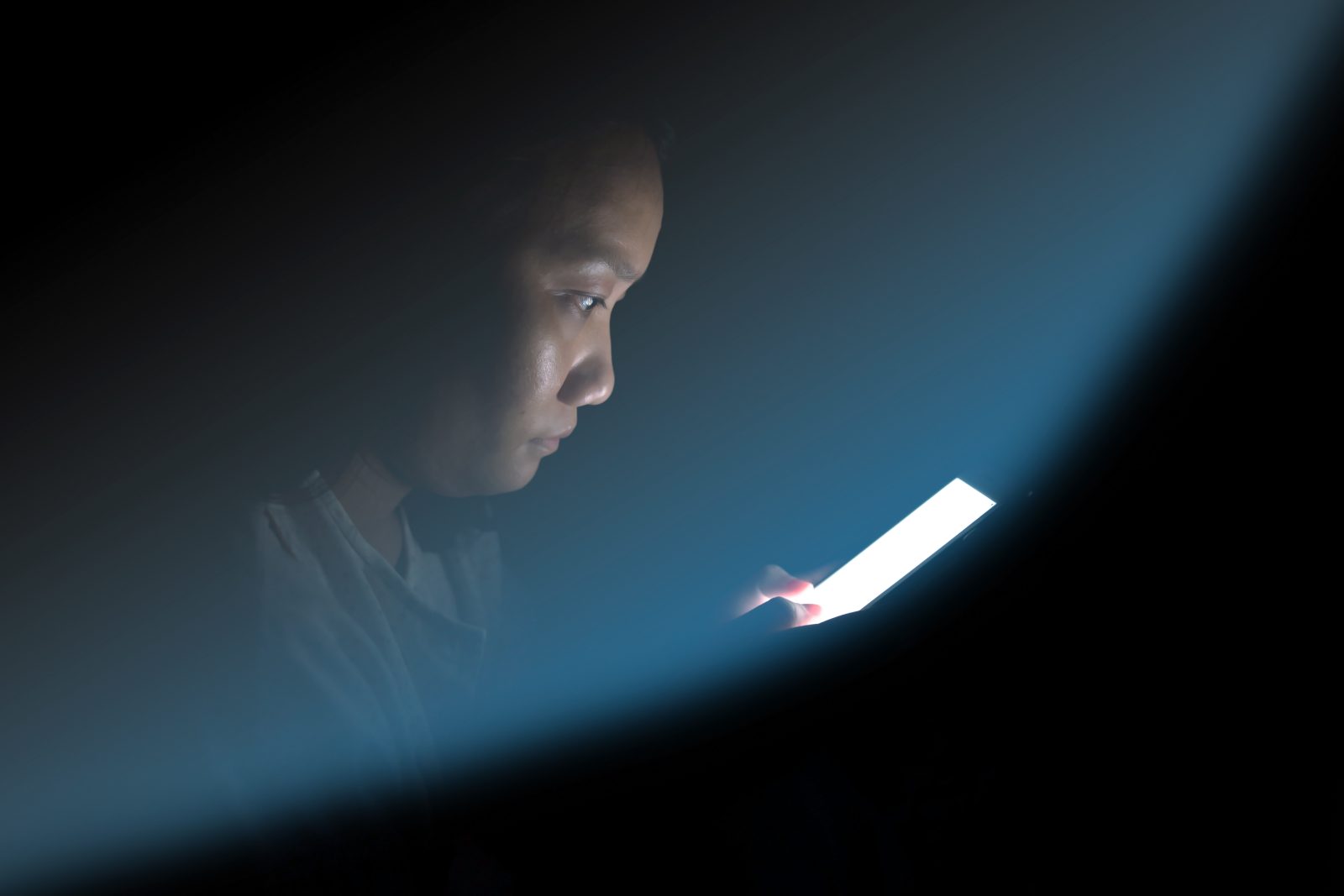You are likely aware by now that using electronic devices such as laptops, phones, or tablets before bedtime isn’t the best habit. This is primarily due to how blue light emitted from these screens affects your circadian rhythm, which is your body’s internal clock.
Researchers suggest that exposure to light at night contributes to sleep deprivation, leading to issues such as weight gain, low energy levels, and depressive moods.
The connection between blue light and these health concerns underscores the importance of managing screen time, especially before sleep.
In the sections below, we’ll explore how blue light differs from other light wavelengths, the effects it has on your body – both beneficial and detrimental – and offer simple strategies to manage your exposure effectively to improve sleep quality.
Understanding Blue Light
Blue light is a segment of the visible light spectrum characterized by its short wavelengths and high energy. According to All About Vision, blue light is generally defined as visible light ranging from 380 to 500 nanometers (nm).
Within this range, blue light is often further divided into blue-violet light (approximately 380 to 450 nm) and blue-turquoise light (approximately 450 to 500 nm).
What Does Blue Light Do?
Blue light plays a crucial role in regulating our “biological clock,” or circadian rhythm, which influences a variety of physical and psychological processes. These include:
- Alertness: Exposure to blue light can increase alertness and help maintain focus, making it easier to stay awake and attentive during the day.
- Sleep: Blue light affects the production of melatonin, a hormone that regulates sleep. Exposure to blue light in the evening can suppress melatonin production, making it harder to fall asleep.
- Mood: Adequate exposure to blue light, particularly during the day, can improve mood and energy levels. This is why light therapy is often used to treat seasonal affective disorder (SAD).
- Motivation and Memory: Blue light influences cognitive functions such as motivation and memory, aiding in overall mental performance.
- Appetite and Blood Sugar Regulation: Blue light exposure impacts metabolic and endocrine functions, including appetite control and blood sugar levels.
Bright blue light stimulates specialized cells in the retina known as intrinsically photosensitive retinal ganglion cells (ipRGCs). These cells send signals to the hypothalamus, a region of the brain that plays a vital role in controlling circadian rhythms and various metabolic and endocrine functions.
This connection helps synchronize the body’s internal clock with the external environment, regulating sleep-wake cycles and other physiological processes.
Sources of Blue Light Exposure
You encounter blue light from various sources, both outdoors and indoors:
- Sunlight: The primary source of blue light. The scattering of blue light rays in the atmosphere gives the sky its blue color on clear days.
- Artificial Lighting: Fluorescent and LED bulbs used in homes and workplaces emit significant amounts of blue light.
- Electronic Devices: Display screens of computers, laptops, tablets, and smartphones are common sources of blue light. Although the intensity is less than that of sunlight, the prolonged use of these devices can impact your circadian rhythm.
- Light Therapy Boxes: Used to treat conditions like seasonal affective disorder (SAD). These boxes emit bright blue light to mimic sunlight and improve mood and energy levels.
Chronic exposure to blue light, especially during nighttime, can lead to sleep disturbances, eye strain, and potentially contribute to the development of age-related macular degeneration (AMD).
To reduce blue light exposure, especially in the evening, consider using blue light filters on devices, wearing blue light blocking glasses, and maintaining a regular sleep schedule that limits screen time before bed.
Blue light exposure during daytime has therapeutic benefits, including improving alertness and cognitive function. It is used in various therapies to combat mood disorders and enhance overall well-being.
How Does Blue Light Affect Sleep?
Blue light exposure in the evening can significantly disrupt sleep patterns by interfering with the body’s circadian rhythm. The circadian rhythm is an internal clock that regulates the sleep-wake cycle and determines when you feel sleepy or alert.
When you use digital devices close to bedtime, the blue light emitted from these screens can delay the release of melatonin, a hormone that regulates sleep. This makes it one of the most common sleep-depriving habits people have.
Normally, melatonin levels rise in the evening, signaling to your body that it’s time to wind down and prepare for sleep. Blue light exposure inhibits this process, making it harder to fall asleep and maintain restful sleep throughout the night.
Disrupted circadian rhythms and reduced melatonin levels are linked to several health issues:
- Sleep Disorders: Chronic exposure to blue light at night can lead to insomnia or poor sleep quality, resulting in sleep deprivation and its associated consequences.
- Metabolic Health: There is growing evidence that misaligned circadian rhythms can increase the risk of metabolic disorders such as diabetes and obesity. Sleep deprivation affects insulin sensitivity and appetite regulation, potentially leading to weight gain and impaired blood sugar control.
- Cardiovascular Health: Poor sleep quality and disrupted sleep patterns are also associated with a higher risk of heart disease. The body’s inability to rest and recover adequately during sleep can contribute to elevated blood pressure and increased stress on the cardiovascular system.
- Mental Health: Lower melatonin levels and poor sleep can contribute to mood disorders such as depression and anxiety. Adequate sleep is crucial for emotional regulation and mental health, and its disruption can have profound effects on overall well-being.
Recent studies suggest that the effects of blue light on melatonin suppression and circadian rhythm disruption may have broader health implications.
Lower melatonin levels have been linked with an increased risk of certain cancers, particularly breast and prostate cancer. While more research is needed to fully understand these connections, it underscores the importance of managing blue light exposure.
Blue Light Impact on Eye Health
Blue light, part of the visible light spectrum with short wavelengths and high energy, has garnered attention for its potential effects on eye health.
Extended exposure to the screens of digital devices, which emit blue light, can cause a condition known as computer vision syndrome (CVS) or digital eye strain. Symptoms include:
- Eye Strain: Prolonged viewing of screens leads to increased muscle tension around the eyes, resulting in discomfort and fatigue.
- Dryness and Irritation: Reduced blinking while staring at screens can cause dryness and irritation of the eyes.
- Difficulty Focusing: Continuous exposure to unfocused light can make it challenging for the eyes to maintain focus.
- Squinting: Straining to see text clearly on screens may lead to frequent squinting, exacerbating eye discomfort.
While the immediate symptoms of eye strain are well-documented, concerns also extend to potential long-term effects on eye health due to frequent exposure to blue light.
Unlike UV light, a significant portion of visible blue light penetrates deeply into the eye, reaching the retina. This exposure may contribute to oxidative stress and damage to retinal cells over time.
Some studies suggest a potential link between blue light exposure and an increased risk of age-related macular degeneration (AMD), a leading cause of vision loss in older adults.
However, conclusive evidence is currently lacking, and eye doctors remain cautious about definitive conclusions.
4 Ways to Limit Blue Light Exposure
- Manage Electronic Device Use Before Bedtime
Using electronic devices such as phones, tablets, and computers close to bedtime can disrupt your internal clock, leading to difficulties falling asleep and daytime fatigue.
Experts recommend avoiding screens at least two to three hours before bedtime. If screen use is unavoidable, opt for devices equipped with blue light filters or use software applications that reduce blue light emissions.
During the day, limit the proximity and duration of screen use, especially without breaks, to reduce overall exposure to blue light.
- Filter Blue Light with Glasses and Apps
To mitigate the impact of blue light on your eyes while using electronic devices, consider the following options:
- Blue Light Blocking Glasses: These glasses feature lenses with a special coating or tint that filters out blue light wavelengths. Amber or yellow-tinted lenses are common and can enhance contrast, reduce eye strain, and improve comfort during prolonged screen use. Consult with an eye care professional to determine the most suitable type of blue light filtering glasses for your needs, whether you wear prescription lenses or not.
- Blue Light Filtering Apps: Many smartphones, tablets, and computers offer apps that can reduce the amount of blue light emitted by adjusting screen settings. These apps can be particularly useful for evening use when minimizing blue light exposure is crucial for maintaining healthy sleep patterns.
- Seek Daytime Sunlight Exposure
Daytime exposure to natural sunlight helps regulate your circadian rhythm by signaling to your body that it is daytime. This exposure supports the production of hormones that promote wakefulness during the day and improve sleep quality at night.
Aim to spend at least 30 minutes outdoors each day, especially during the early morning hours, or position yourself near windows to maximize natural light exposure.
- Consider Lighting Choices
The type of lighting in your environment can also impact your exposure to blue light:
- LED and Fluorescent Lights: These types of bulbs emit more blue light than traditional incandescent bulbs. Consider using bulbs with coatings that produce warmer, less blue light, which is less disruptive to circadian rhythms and melatonin production.
- Incandescent Lights: Although they emit less blue light than LEDs and fluorescents, consider using warmer incandescent bulbs in areas where you spend time before bedtime, such as your bedroom.
Ensure your overall eye health by wearing glasses with the correct prescription if needed and maintaining adequate eye moisture to prevent dryness.
To alleviate eye strain during prolonged screen use, take a break every 20 minutes to focus on an object at least 20 feet away for 20 seconds.
Conclusions
Managing blue light exposure is essential for protecting eye health and maintaining healthy sleep patterns in our modern, screen-centric world.
By adopting these strategies – limiting screen time before bed, using blue light filtering glasses or apps, seeking daylight exposure, and selecting appropriate lighting options – you can minimize the potential adverse effects of blue light and promote overall eye wellness.
Incorporating these practices into your daily routine supports optimal eye function and contributes to a better quality of life.















Find Us on Socials